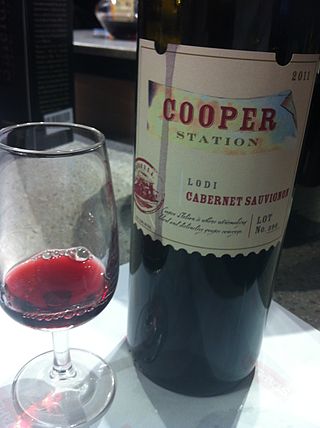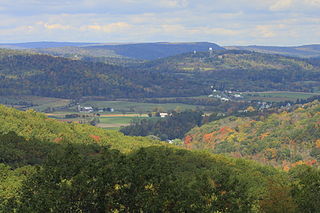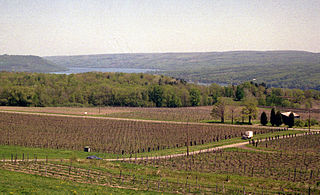Related Research Articles

Willamette Valley is an American Viticultural Area (AVA) which lies in the Willamette Valley of Oregon. The AVA is the wine growing region which encompasses the drainage basin of the Willamette River. It stretches from the Columbia River in the north to just south of Eugene in the south, where the Willamette Valley ends; and from the Oregon Coast Range in the west to the Cascade Mountains in the east. At 5,360 square miles, it is the largest AVA in the state, and contains most of the state's wineries; approximately 908 as of 2021.

The Southern Oregon AVA is an American Viticultural Area which lies in Southern Oregon, United States. The Southern Oregon AVA was established in 2005 and was created to include the land of two smaller AVAs: the Rogue Valley AVA and the Umpqua Valley AVA. Southern Oregon AVA was established to allow the two principal winegrowing regions in the southern part of the state to market themselves jointly. This creation of a "super-AVA" is a departure from the trend in the Willamette Valley AVA or northern Oregon of establishing smaller AVAs specific to a particular locale's climate or soil conditions.

Lodi AVA is an American Viticultural Area located in the Central Valley of California, at the northern edge of the San Joaquin Valley east of San Francisco Bay. The AVA gained approval as a designated wine growing area in 1986 and includes 551,000 acres (223,000 ha) of which 103,000 acres (42,000 ha) are currently planted with wine grapes. In 2002, the area included in the AVA was expanded by 93,500 acres (37,800 ha) along the southern and western portions of the original AVA boundaries in San Joaquin County. The appellation includes land in southern Sacramento County and northern San Joaquin County. It is bounded on the west by Interstate Highway 5 and to the east by the political borders for the adjacent El Dorado, Amador, and Calaveras Counties.
The Jahant AVA is an American Viticultural Area located within the Lodi AVA. Most of the AVA is located within San Joaquin County, California, with a small part in Sacramento County. At 28,000 acres (11,331 ha), Jahant is the smallest of the Lodi sub-appellations. The area is known for its distinctive pink colored Rocklin-Jahant loam soil with the AVA's boundaries being delineated by the extent and reaches of the soil. This low-lying AVA is affected by its close proximity to the Mokelumne River and the Sacramento-San Joaquin River Delta which keeps the climate cool and dry.

Sierra Foothills is a vast American Viticultural Area (AVA) encompassing the foothill "belt" of the Sierra Nevada in north-central California, United States. It was established on December 18, 1987 by the Bureau of Alcohol, Tobacco and Firearms (ATF), Treasury after evaluating the petition filed by the Sierra Foothills Winery Association of Somerset, California for the establishment of a "Sierra Foothills" viticultural area in portions of Yuba, Nevada, Placer, El Dorado, Amador, Calaveras, Tuolumne and Mariposa Counties. Wine grapes were introduced to the area in the nineteenth century during the California Gold Rush. Over 280 vineyards/wineries are located within its boundaries.
The Alta Mesa AVA is an American Viticultural Area entirely located within the Lodi AVA in Sacramento County, California in the United States. The appellation's name is Spanish for "high table", a reference to the higher elevation of the land compared to the surrounding terrain.

El Dorado is an American Viticultural Area (AVA) located in El Dorado County, California, east of the state’s capital, Sacramento and centered around the county seat of Placerville. It was established on November 14, 1983 by the Bureau of Alcohol, Tobacco, Firearms and Explosives (ATF), Treasury after approving the submitted petition from the El Dorado Wine Grape Growers Association of Camino, California applying to establish a viticultural area named "El Dorado.” The area includes parts of El Dorado County on the north border by the Middle Fork American River and on the south by the South Fork of the Cosumnes River. El Dorado viticultural area lies within the vast 4,062 square miles Sierra Foothills viticultural area, one of the largest appellations in California, which extends about 170 miles (274 km) through portions of Yuba, Nevada, Placer, El Dorado, Amador, Calaveras, Tuolumne and Mariposa Counties. The El Dorado viticultural area encompasses 1,093,120 acres (1,708 sq mi) which entirely includes Fair Play and a small portion of northeastern California Shenandoah Valley AVAs.

The Fair Play AVA is an American Viticultural Area in El Dorado County, California, United States. It is entirely contained within the boundaries of the El Dorado AVA and the Sierra Foothills AVA. The boundaries of the Fair Play AVA include rolling hills at elevations between 2,000 feet (610 m) and 3,000 feet (914 m) above sea level, making it the California appellation with the second highest average elevation after the Squaw Valley-Miramonte appellation. The soils are decomposed granite as part of the Sierra Nevada Foothills region, and the area is within the Cosumnes River watershed. The most popular red wine grape variety is Zinfandel, although varieties popular in southern Rhone Valley France and Italy, such as Syrah, Grenache, Mourvedre, Sangiovese, Tempranillo and Barbera are the common varietals. White wine is less popular in this AVA, but significant plantings of Viognier and Grenache Blanc, along with Chardonnay are most common.
The McDowell Valley AVA is an American Viticultural Area located in southeastern Mendocino County, California near Hopland. The wine appellation is located on sloped bench land at elevations as high as 1,000 feet (300 m) above sea level that overlook the Russian River to the west. McDowell Valley is slightly cooler than the surrounding areas of Mendocino County. McDowell Valley Vineyards is currently the only winery operating within the boundaries of the AVA.
The Malibu-Newton Canyon Valley AVA is an American Viticultural Area in Los Angeles County, California. The boundaries of the AVA include Newton Canyon, located about 4 miles (6 km) from the Pacific Ocean within the city limits of Malibu. George Rosenthal planted the first vineyards planted in the area since Prohibition in 1987, and was successful in his petition for the creation of the AVA in 1996. The canyon varies in elevation from 1,400 feet (427 m) to 2,800 feet (853 m) above sea level. Coastal fog and wind can influence the microclimate of the canyon, providing a cooler climate than the surrounding areas.
The Borden Ranch AVA is an American Viticultural Area located in both Sacramento County and San Joaquin County, California. It is part of the larger Lodi AVA. Located in the east central portion of the Lodi area, Borden Ranch vineyards are located at altitudes between 73 feet (22 m) and 520 feet (158 m) above sea level. The northern edge of the AVA is defined by Laguna Creek and the southern edge is defined by Dry Creek, both of which flow out of the foothills of the Sierra Nevada Mountains into the San Joaquin Valley. The soils in Borden Ranch is alluvial with cobbles, clay pan, and clay loam. Red wine grape varietals are the most commercially important grapes in the area.

The Mokelumne River AVA is an American Viticultural Area located in San Joaquin County, California. It is located in the southwest part of the larger Lodi AVA, and includes the city of Lodi and the towns of Woodbridge and Acampo. The AVA is named after the Mokelumne River, which drains out of the Sierra Nevada Mountains into the San Joaquin River and passes through the heart of the appellation. The wine region includes a portion of the lower Mokelumne River and the Cosumnes River, a tributary. The Mokelumne River AVA covers 87,500 acres (35,410 ha), of which 42,000 acres (16,997 ha) are planted to wine grapes. The soil in the area is alluvial fan deposits of sand and loam. Ample rainfall and soil moisture retention allows most grape growers to farm without the use of irrigation.
The Clements Hills AVA is an American Viticultural Area located in San Joaquin County, California. It is located in the southeast part of the larger Lodi AVA. The Mokelumne River flows through the wine region, which is composed of rolling hills between 90 feet (27 m) and 400 feet (122 m) in elevation. A variety of microclimates exist within the hills of the region. The soils in the area includes loams, clay loams, and clays. Below the alluvial top soil are areas of granite and volcanic soils.
The Sloughhouse AVA is an American Viticultural Area located in Sacramento County, California. It is in the northeast part of the larger Lodi AVA. Sloughhouse has the warmest climate in the Lodi region. Elevations in Slouhhouse AVA reach as high as 590 feet (180 m) above sea level, reducing the influence of fog that keep lower elevation areas in Lodi cooler. Sloughhouse is considered by some to be a transitional climate and terrain between the characteristics of the wine regions of the Central Valley and the nearby Sierra Foothills AVA.
The Dunnigan Hills AVA is an American Viticultural Area located in the Dunnigan Hills, in Yolo County, California. Located in the northwest portion of Yolo County, the wine region has a Mediterranean climate that is less prone to frost than other parts of the Sacramento Valley. The largest winery in the Dunnigan Hills is R.H. Phillips, which has a 1,300 acres (526 ha) estate vineyard.
The Clarksburg AVA is an American Viticultural Area that spans three counties in California's Sacramento Valley. Located in portions of Sacramento County, Solano County, and Yolo County, the Clarksburg AVA includes 64,640 acres (26,159 ha) near the town of Clarksburg. The growing region has dense clay, silt, and loam soils. Fog and cool breezes from San Francisco Bay keep the Clarksburg area cooler than nearby Sacramento. 90% of the grapes grown in the Clarksburg AVA are crushed in winery facilities located elsewhere in California, and relatively few wines are released with the Clarksburg AVA on their labels.

The Merritt Island AVA is an American Viticultural Area located in Yolo County, California. Part of the larger Clarksburg AVA, Merritt Island is a 5,000 acres (2,023 ha) island in the Sacramento River Delta. The island is surrounded by Elk Slough, Sutter Slough, and the Sacramento River. The island soil is a very fertile and rich loam. Cool breezes and fog arriving from the nearby San Francisco Bay create a cool maritime climate. Most grapes grown on Merritt Island are used in blends with grapes from other parts of the state. Merritt Island is administered under Reclamation District 150.

The Diablo Grande AVA is an American Viticultural Area located in Stanislaus County, California. All 30,000 acres (12,141 ha) in the AVA are owned by the Diablo Grande Resort Community, and Isom Ranch Winery is the only winery producing wines that carry the Diablo Grande AVA designation on their labels. Vineyards in the AVA are planted between 1,000 feet (300 m) and 1,800 feet (550 m) above sea level. The region is named after nearby Mount Diablo, the highest peak in the Pacific Coast Range.

The Catoctin AVA is an American Viticultural Area located in the Frederick and Washington counties of western Maryland. The region is bordered by Catoctin Mountain to the east, the Pennsylvania border to the north, South Mountain to the west, and the Potomac River to the south. "Catoctin" is Algonquian for "speckled rock", a geological feature of the area. Two commercial wineries operate in the AVA. The hardiness zones are 7a and 6b.

The Cayuga Lake AVA is an American Viticultural Area around Cayuga Lake in Upstate New York. The boundaries of the AVA include portions of Cayuga, Seneca, and Tompkins counties. Most of the vineyards in the AVA are planted in the shale soils of the hillsides on the western side of Cayuga Lake. Vineyards are planted at a range of elevations above the surface of the lake, up to 800 feet (244 m) higher. The steep hillsides and the lake together form a unique micro-climate in autumn that helps extend the growing season by preventing cold air from settling and producing frost. The Cayuga grape variety was created in this region by researchers at Cornell University.
References
- ↑ Code of Federal Regulations. "§ 9.198 Cosumnes River." Archived 2008-01-19 at the Wayback Machine Title 27: Alcohol, Tobacco and Firearms; Part 9 — American Viticultural Areas; Subpart C — Approved American Viticultural Areas. Retrieved Jan. 28, 2008.
- 1 2 3 Appellation America (2007). "Cosumnes River (AVA): Appellation Description" Archived 2008-01-31 at the Wayback Machine . Retrieved Jan. 25, 2008.
- 1 2 Rieger, Ted (2003). "Subdividing Lodi—Proposal Supported for 7 Sub-AVAs". Wine Business Monthly. Aug., 2003.